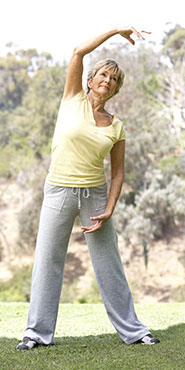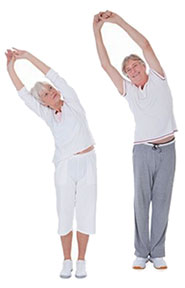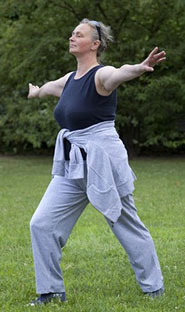Ooh My Aching Back
by Amy ShouseMovement is the best remedy
Keep Your Back Healthy
Karin Yehling, a personal fitness trainer for 23 years and founder of Function First Fitness, shares her extensive experience working with injuries and older bodies.
Flexibility, in and of itself, is not age-dependent. However, because we have used poor body mechanics, mostly when sitting, we lose flexibility. Since the back is only an assistant and not a main player, it can’t take the stress of tight muscles pulling from any direction over a prolonged period of time.
To gain more flexibility, start with the ankles. If the ankles don’t work, neither does anything else going up the chain. This is also a big reason for knee issues as we age.
Ankle rotation: In a comfortable sitting or lying position, raise your leg and gently rotate your ankle in a full circle. Repeat three times in one direction, then three rotations in the other direction. Switch legs and repeat. This is a great way to start your day before you even get out of bed.
Active ankle stretch: Stand facing a wall, a few inches from the wall. (If you need to hold onto the back of a chair for balance initially, place it to the side, with the back facing you.) Place one foot near the wall so that the toes are about two to three inches from the wall. The other leg is behind you. While keeping the front foot heel down, bend your knee to gently touch the wall, then straighten your front knee back to the starting position. If you can’t do this while keeping your front heel on the ground, move closer to the wall. This action also stretches the calf of the rear leg. Repeat 10-15 times on each side daily.
In the hips, some muscles cross the hip joint and attach onto the lower spine. These are the hip flexors, located on the front area of the hip.
Hip flexor stretch: Stand facing a chair, one foot up on the chair, the other on the ground. (If you need another chair for balance, place it to the side, back facing you.) Pull your hips underneath you and shift your weight to the forward leg slightly. This should create a stretch on the front part of the hip of the “down” leg. Hold for 30 seconds, switch and repeat 2–3 times.
Movement in general, is key. If all segments of the spine aren’t moving fluidly, breakdown in the form of arthritis occurs.
Side twist: Sitting on the edge of a chair, gently reach around with your right hand and shoulder to get as close as you can to touching your left hip. Use your shoulder to help you with the twist. Come back to center, pause, then reach around with your left hand to your right hip. Alternate three times on each side, pausing between twists at center.
Leg bridge: Lie flat on your back, bending your knees with feet flat on the floor. Tighten tummy (important for back support) and lift hips as high as you can, then lower slowly. Repeat 10–15 times.
With 26 bones, or vertebrae in the back, there’s plenty of opportunity for something to go wrong over the course of a lifetime. Apart from actual injury, the degenerative effects of time—often manifested in a normal thinning of the intervertebral discs—can result in such spinal conditions as osteoarthritis, osteoporosis or spinal stenosis. Further exacerbating the problem is our increasing tendency to simply sit too much, in activities that range from driving a car to watching television. Not only are we shaving years off our lives, but fully 70 percent of older Americans suffer from chronic back pain.
When we’re in pain, the natural tendency is to “take it easy,” but counterintuitive as it may seem, getting up and moving is often the best way to alleviate discomfort. Finding that balance between pushing to be more active, and protecting against injury, can be challenging, especially when starting a new program.
 Katherine Newmark, a 60-year-old yoga teacher in Los Angeles, knows firsthand the conundrum seniors are faced with when attempting to stay active. “At a certain age, there isn’t a person who has no injuries or aches and pains,” she says. “But the way you keep from getting worse, or hopefully fix the issues, is by moving.” Newmark suggests gentle restorative yoga or taking a daily walk, where there is also an emphasis on deep breathing.
Katherine Newmark, a 60-year-old yoga teacher in Los Angeles, knows firsthand the conundrum seniors are faced with when attempting to stay active. “At a certain age, there isn’t a person who has no injuries or aches and pains,” she says. “But the way you keep from getting worse, or hopefully fix the issues, is by moving.” Newmark suggests gentle restorative yoga or taking a daily walk, where there is also an emphasis on deep breathing.
Newmark notes that many older people resist engaging in any type of exercise for fear of getting an injury, or aggravating an injury they already have. But not doing anything isn’t going to help in the long run, she says. “If a person has arthritis, this causes pain, but if you do nothing you’re just going to feel worse. The solution, then, is to come up with a movement plan that’s doable, whether it be a mild yoga practice or walking practice or simple stretching in a chair.”
Dr. Rachel West, who practices osteopathy—a type of drug-free, non-invasive manual manipulation—in Santa Monica, echoes the importance of stretching in order to remain as flexible as possible. She notes that one of the primary causes of back pain is inflexibility, especially in the hips and hamstrings.
“As we age, hormone levels decline,” West says. “So many men and women who lose estrogen and testosterone suffer joint space narrowing because the cartilage wears away, and this can cause pain and even lead to bone fractures.” West goes on to explain that the discs between the bones tend to get drier and shorter as we age, creating discomfort and less flexibility, which often prompt us to avoid exercise.
 West advises several things an older person can do to cultivate flexibility and spine health. Posture is key, she says—being aware of standing tall and not slumping over. Wearing comfortable shoes that fit correctly is also critical; many people wear shoes with too-high heels or that squish their toes. This can cause damage to the sciatic nerve, which acts as a feedback loop from the feet up through the legs and to the back, so uncomfortable or poorly made shoes can be detrimental to back and spine health.
West advises several things an older person can do to cultivate flexibility and spine health. Posture is key, she says—being aware of standing tall and not slumping over. Wearing comfortable shoes that fit correctly is also critical; many people wear shoes with too-high heels or that squish their toes. This can cause damage to the sciatic nerve, which acts as a feedback loop from the feet up through the legs and to the back, so uncomfortable or poorly made shoes can be detrimental to back and spine health.
Learning to pick things up with proper bending—using the thigh muscles and not just bending over from the weakest part of the back—is also important. And low-stress activities, such as t’ai chi, qi gong and yoga, encourage a greater awareness of how the body moves, leading to more flexibility and better posture. This can help existing back pain, prevent future back pain, and improve understanding of the relationships among feet, knees and hips.
How we describe the recommendation is also key. There may be objections to an unfamiliar form of movement, while a program of “gentle stretching” is less likely to encounter resistance. So for an older person afraid of injury or wheelchair bound, West suggests a shift in presentation.
West also recommends acupuncture, since it can help decrease inflammation. “There are many similar techniques in osteopathy that, like acupuncture, are founded on the belief that alignment of  the physical body as well as mental, psychological and spiritual health is very important for overall health,” says West, adding that osteopaths use techniques that help with body alignment to increase flexibility.
the physical body as well as mental, psychological and spiritual health is very important for overall health,” says West, adding that osteopaths use techniques that help with body alignment to increase flexibility.
“There are so many things the elderly can do to improve their flexibility and alignment,” West advises. ”Walking is a phenomenal, simple exercise, as long as there is stretching before and after.” Other recommendations include simple twists while sitting in a chair, leg lifts while lying in bed, and lifting arms up and down over your head. Even simple breathing awareness while sitting can be extremely beneficial.
“As you learn to become more relaxed, you can be conscious and present while you’re living your life and getting things done,” says West. “So that’s a nice balance as a human being. Then you’re going to be able to release those tight muscles pulling on joints, causing you back pain.”
